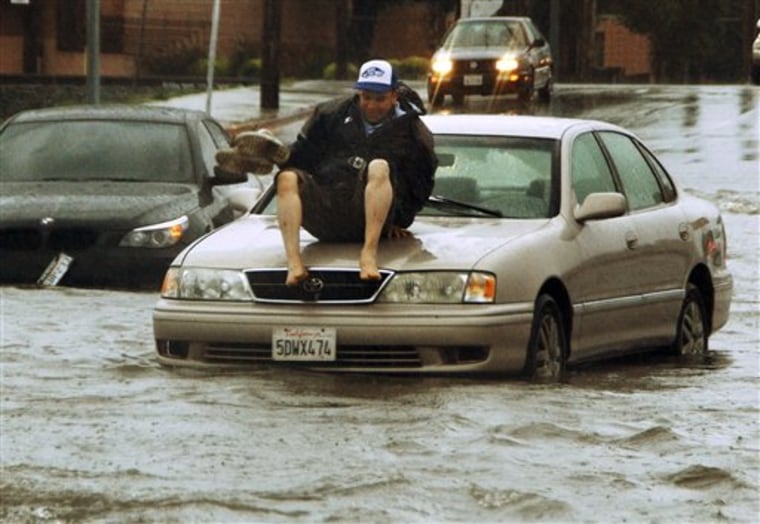A fierce spring storm that stranded hundreds of drivers along a major freeway and forced people to flee the threat of a mudslide dwindled to showers on Monday, as a new wet weather system headed toward California.
Snow and ice closed Interstate 5 for more than 12 hours beginning late Sunday, forcing travelers to spend the night at motels, gas stations or along the side of the main route linking Southern and Northern California until authorities began escorting traffic through the pass.
People tried the make the most of the challenging situation.
"I had 150 people. They were all over, man," said Jesse Khalid, who worked the overnight shift at a service station in Lebec, along the 4,100-footTejon Pass. "Most of them came in my store. They started drinking coffee, partying."
Gaylin Heitzig of Visalia and her daughter slept in the back seat of their car, snuggled up with two blankets and their two dogs.
"We tried to stay warm. Thank God we had our dogs," Heitzig told KABC.
The section of Interstate 5 known as the Grapevine often closes during bad weather.
The storm hit first and hardest in Santa Barbara County, where a family of four, including a 6-month-old child and a dog, were rescued Sunday from a sailboat buffeted by wind and waves off East Beach.
During the rescue, a Harbor Patrol boat began taking on water and needed help from a second boat. In addition, a 70-foot tugboat broke free from its anchorage and struck the sailboat, authorities told the Santa Barbara News-Press.
The downpour dumped more than 10 inches of rain in Santa Barbara County.

Elsewhere in the state, the storm toppled trees onto cars and through windows, rainwater collapsed roofs and cars went skating into each other.
The Los Angeles Fire Department said it received 62 percent more 911 calls on Sunday than on average.
"We have debris flow, flooding, electrical wires down, trees that fell onto cars and structures in addition to increased traffic collisions," spokesman Erik Scott said.
However, hillsides stood up well in Southern California foothill communities considered at risk of mudslides because wildfires denuded the slopes last year.
The storm that greeted the first day of spring left several rain records. Downtown Los Angeles got nearly 2½ inches, almost an inch more than the previous record for the day set in 1943, according to the National Weather Service.
Bob Hope Airport in Burbank got 3.85 inches, breaking the 1973 record of 1.15 inches for the day.
The San Fernando Valley had up to 7 inches in some areas.
As many as 30 people in Woodland Hills were evacuated overnight after mud and debris flowed over a retaining wall and threatened six homes. Most were allowed home early Monday although some found their backyards filled with brown goo.
About a half-dozen people remained unable to return to four homes considered unsafe until inspections, Scott said.
"Larger chunks of mud started to fall and it just became a nightmare. It just kept coming and coming and coming," homeowner Jeff Gilbert told KABC.
The nasty weather was moving out of the region and flood advisories were canceled for Los Angeles County,. However, the weather service warned debris flows and flash flooding were still possible in some areas.
Another, milder storm was expected to hit the state on Wednesday.
Wet, windy weather in the San Francisco Bay area on Friday included a small tornado captured on video off Ocean Beach in San Francisco.
Thunderstorms brought hail, and winds topped out around 45 mph at San Francisco International Airport. More of the same was expected in coming days.
Skiers enjoyed up to four feet of fresh powder at higher elevations in the Lake Tahoe region.
There was concern that continuing heavy rains might cause damage to fruit and nut trees and delay the planting of row crops such as tomatoes, garlic and cotton in the San Joaquin Valley.
"Rain is not abnormal this part of the year, but we typically have a storm followed by breezy, dry weather," Fresno County Farm Bureau director Ryan Jacobsen said. "When you have this much rain, the water sits there and makes it very conducive to growth of fungus."
Actual damage may not be visible for weeks, he added.
Thousands of runners in the Los Angeles Marathon faced pouring rain and lightning strikes, one of which illuminated the downtown skyline just as the race started.
Los Angeles County Fire Department paramedics had treated about 100 runners — most for hypothermia.